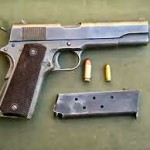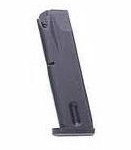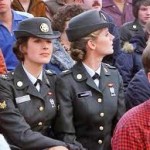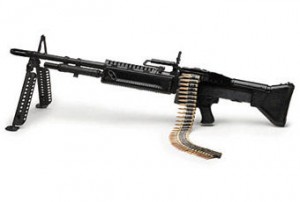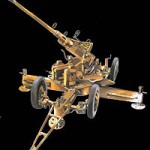Sign me up as an armed guard at Hazardville Memorial. Continue reading
 My town, Enfield, CT, has decided to lead the charge into the armed defense of its schools, one of which, Hazardville Memorial, is almost literally in my back yard. The town council has decided to spend $650,000 this year to hire armed guards for nine grade and middle schools as well as for a Head Start center. My understanding is that preference will be given to “retired law enforcement officials.” I believe that I am perfectly qualified for this job. I hereby submit my credentials.
My town, Enfield, CT, has decided to lead the charge into the armed defense of its schools, one of which, Hazardville Memorial, is almost literally in my back yard. The town council has decided to spend $650,000 this year to hire armed guards for nine grade and middle schools as well as for a Head Start center. My understanding is that preference will be given to “retired law enforcement officials.” I believe that I am perfectly qualified for this job. I hereby submit my credentials.
I served proudly as an MP when I was drafted into the army in 1970-1972. I completed the intense eight-week training course at Ft. Gordon, GA. Actually, my company’s course was abbreviated to seven weeks because of Christmas, but I passed with flying colors. Of particular note is that I, who had qualified as a marksman with the M-16 rifle in basic training, was one of the first in my company to qualify with the .45 caliber handgun at Ft. Gordon. The details of that qualification period are illustrative of my experience.
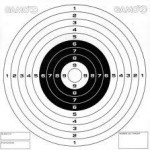 We arrived at the firing range for the first and only time shortly after lunch. The instructors showed us which end of the pistol the bullets could be expected to emerge from, and then the testing began. Four hundred points were available; the passing score was three hundred. The test was divided into two sections in both of which we each fired twenty rounds. In the first section we took our time to brace ourselves, aim, and fire at bullseye targets that contained ten concentric circles. Ten points were awarded if the bullet was in the innermost circle, only one for the largest circle. In the second section of the test we fired at three silhouette targets, which were much easier to hit, and hitting any target scored the full ten points. In this section however, we had to fire much more rapidly, and we were not allowed to brace our arms against anything. The last five shots were at a range of only ten meters and were shot “from the hip.”
We arrived at the firing range for the first and only time shortly after lunch. The instructors showed us which end of the pistol the bullets could be expected to emerge from, and then the testing began. Four hundred points were available; the passing score was three hundred. The test was divided into two sections in both of which we each fired twenty rounds. In the first section we took our time to brace ourselves, aim, and fire at bullseye targets that contained ten concentric circles. Ten points were awarded if the bullet was in the innermost circle, only one for the largest circle. In the second section of the test we fired at three silhouette targets, which were much easier to hit, and hitting any target scored the full ten points. In this section however, we had to fire much more rapidly, and we were not allowed to brace our arms against anything. The last five shots were at a range of only ten meters and were shot “from the hip.”
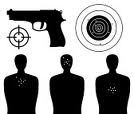 A few guys qualified on the first attempt. Their reward was to return to the barracks early. Since they were the only ones there, and since someone had to help prepare supper, they were assigned to KP.
A few guys qualified on the first attempt. Their reward was to return to the barracks early. Since they were the only ones there, and since someone had to help prepare supper, they were assigned to KP.
I did not do too well in the first test. My score was sixty-eight out of four hundred. One of the other trainees may have achieved a lower score, but I did not hear of anyone. The instructors announced that the rules would be slightly changed for the second round. In order to participate in the second half of the test, you had to get at least one hundred of the two hundred points in the bullseye section. That made sense because it would have been impossible to qualify with anything less.
The sergeants who scored each person’s performance were assigned randomly, and I got a different scorer in the second round. I took careful aim during the first half of the test, and my results improved dramatically. We all walked up to our targets, and I added the result in my head. I proudly determined that I had earned a score of around eighty-eight or ninety on the bullseye alone, more than twice as many points as I managed the first time. This meant that I would not be allowed to shoot at the silhouettes, but it did give me some hope of eventually qualifying if they gave me enough chances. To my surprise, however, the sergeant who was scoring allowed me to shoot at the silhouettes, although he warned me “You will need to hit almost all of the targets.” I shrugged and enthusiastically voiced the obligatory “Yes, sergeant.”
I did even better in the second half. I hit twelve targets out of twenty! The only thing was that half or more of my hits were ricochets — you can tell because whereas the regular holes are round, the ricocheted bullets, which are coming up at an angle, make rectangular holes that are at least twice as high as they are wide. The sergeant, however, examined my silhouettes and declared, “Some of these holes look like they have two or three bullets in them. You qualified.”
When I reached my permanent duty station of Sandia Base (now part of Kirtland Air Force Base) in Albuquerque I was put on patrol for the first few days. I had not yet had the opportunity to put my prowess with the .45 to the test yet when I saw a notice on the bulletin board asking if anyone knew how to type. Now in 1971 typing was not a skill that was common among American males, but I was pretty good at it. I took the typing test and was given the assignment of desk clerk, which meant that while the other members of my squad were protecting the base from criminals and the Communist menace, I ran the radio, typed up forms, and assisted the desk sergeant.
In this new capacity I still toted a .45 in a holster on my belt, and we were given one clip that contained ten rounds. I must say that this arrangement bothered me in that the deadly firearm was pointed at my right foot all day long, and I knew that I walked a lot better when there was not a hole in it. So, I always removed the clip from my weapon and placed it safely in my pocket. Do not for a moment think that this act in any way put the Provost Marshall’s Office in which I worked in jeopardy. If a miscreant attacked us, I was fully prepared to throw my gun at him/her, and I was much more confident in my aim when I used the gun that way than in the conventional manner.
My mettle was put to the test one summer afternoon when a dozen or so peace-crazed Gandhiists attacked our base, which is to say that they sat in one of the main streets and disrupted traffic. The MP Company was deployed to take care of the situation, although in this case we were not allowed to take our weapons. I was foresighted enough to bring a clipboard with a few papers on it. When we were ordered to pick up the insurgents and place them in trucks, I walked around with a supervisory air. For this activity I was awarded a letter of commendation.
Incidentally, in all of my time as an MP I never encountered a female MP. The two MP’s in the movie Stripes bore no resemblance to anyone whom I met in any facility in any branch of the military.
-
- I will obviously need to be able to match the potential assailant in firepower. The shooter at Sandy Hook brought into the school a Bushmaster AR-15, a Glock 10mm semi-automatic pistol, and a Sig Sauer 9mm. He also had a shotgun in the trunk of his car. One must remember that that punk in Newtown knew that he would meet no resistance. I must be prepared for one or more assailants who know that the school and its children will be defended. I therefore will need at least three fully automatic weapons, perhaps an M-60 and a pair of Uzi SMG pistols with magazines that hold up to thirty-two rounds. Some sort of surface-to-surface missile launcher should also be provided in case the assailants are able to obtain an armored vehicle. Night-vision goggles would be required for parent-teacher meetings that might be held in the evenings.
- Access to the school must be controlled. All doors except the main door must be permanently blocked. A waiver from the fire department might be required. All glass windows must be replaced by bulletproof plexiglass and sealed.
- Recess will not be eliminated, but we cannot afford to offer the assailants a soft target when the children are outside and susceptible to both bombing and strafing attacks. Perhaps the children can do isometric exercises indoors.
- The buses are a weak point. Their undercarriages should be armored to protect them against IED’s, and the bus drivers must be provided with sufficient firepower to protect the students.
- Never forget that death can come from the sky. What is to prevent someone from obtaining an airplane and crashing it into the school? A simple anti-aircraft battery stationed on the roof and manned 24/7 should suffice.
- Some additional personnel will probably be required: trainers, the men manning the roof-based weapons, backups, and there may be others. Their salaries and benefits may entail some additional cost. Is it too much to pay to keep our children safe?
- All field trips, athletic events, and the like, whether sponsored by the school or not will be canceled until such activities demonstrate that they can meet the common-sense standards being proposed for the schools themselves.

